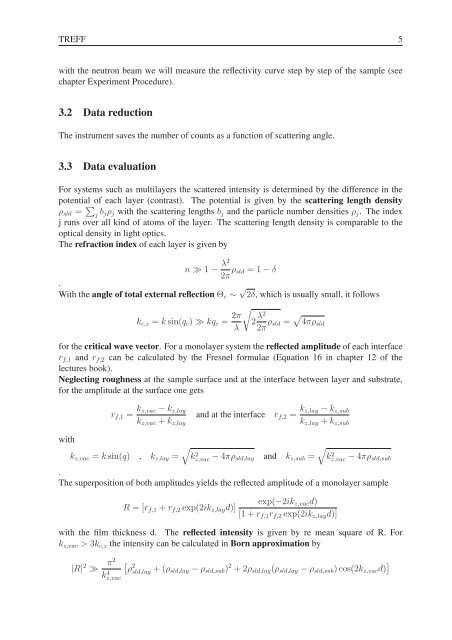Neutron Scattering - JUWEL - Forschungszentrum Jülich
Neutron Scattering - JUWEL - Forschungszentrum Jülich
Neutron Scattering - JUWEL - Forschungszentrum Jülich
You also want an ePaper? Increase the reach of your titles
YUMPU automatically turns print PDFs into web optimized ePapers that Google loves.
TREFF 5<br />
with the neutron beam we will measure the reflectivity curve step by step of the sample (see<br />
chapter Experiment Procedure).<br />
3.2 Data reduction<br />
The instrument saves the number of counts as a function of scattering angle.<br />
3.3 Data evaluation<br />
For systems such as multilayers the scattered intensity is determined by the difference in the<br />
potential of each layer (contrast). The potential is given by the scattering length density<br />
ρsld = �<br />
j bjρj with the scattering lengths bj and the particle number densities ρj. The index<br />
j runs over all kind of atoms of the layer. The scattering length density is comparable to the<br />
optical density in light optics.<br />
The refraction index of each layer is given by<br />
n ≫ 1 − λ2<br />
2π ρsld =1− δ<br />
.<br />
With the angle of total external reflection Θc ∼ √ 2δ, which is usually small, it follows<br />
kc,z = k sin(qc) ≫ kqc = 2π<br />
�<br />
2<br />
λ<br />
λ2<br />
2π ρsld = � 4πρsld<br />
for the critical wave vector. For a monolayer system the reflected amplitude of each interface<br />
rf,1 and rf,2 can be calculated by the Fresnel formulae (Equation 16 in chapter 12 of the<br />
lectures book).<br />
Neglecting roughness at the sample surface and at the interface between layer and substrate,<br />
for the amplitude at the surface one gets<br />
with<br />
rf,1 = kz,vac − kz,lay<br />
kz,vac + kz,lay<br />
kz,vac = k sin(q) , kz,lay =<br />
and at the interface rf,2 = kz,lay − kz,sub<br />
kz,lay + kz,sub<br />
�<br />
k2 �<br />
z,vac − 4πρsld,lay and kz,sub = k2 z,vac − 4πρsld,sub<br />
.<br />
The superposition of both amplitudes yields the reflected amplitude of a monolayer sample<br />
R =[rf,1 + rf,2 exp(2ikz,layd)]<br />
exp(−2ikz,vacd)<br />
[1 + rf,1rf,2 exp(2ikz,layd)]<br />
with the film thickness d. The reflected intensity is given by re mean square of R. For<br />
kz,vac > 3kc,z the intensity can be calculated in Born approximation by<br />
|R| 2 ≫ π2<br />
k4 � 2<br />
ρsld,lay +(ρsld,lay − ρsld,sub)<br />
z,vac<br />
2 +2ρsld,lay(ρsld,lay − ρsld,sub)cos(2kz,vacd) �

















